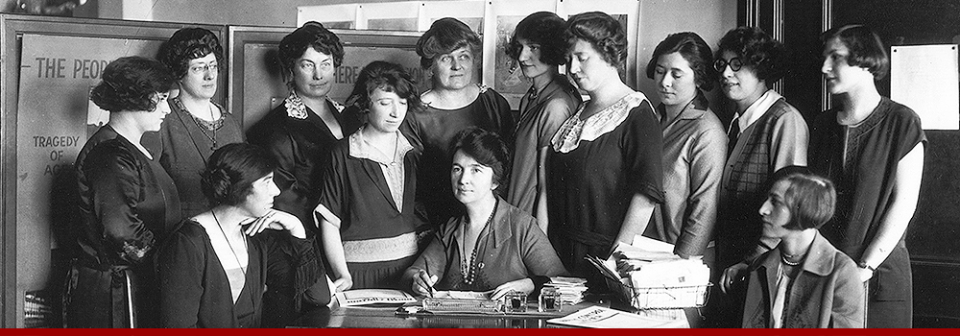By Ann Ormsby
Sometimes a person changes the course of history and no one knows her name. Sadie Sachs is one such person. Who was she? She was a poverty-stricken young mother living on the Lower East Side in 1912 who ignited a passion in another young woman, Margaret Sanger, who changed the way women control their bodies today.
Sadie Sachs was a 28-year-old, married mother of three young children, when she found herself pregnant again. At that time, women could get an illegal abortion for five dollars and that is what Sachs did. Sanger, a nurse, was called on to go to Sachs’ home when Sachs started to bleed uncontrollably. The first time this happened, Sanger nursed Sachs back to health.
As soon as Sachs was recovered she asked her doctor what she could do to prevent another pregnancy. Legend has it that the doctor laughed and said, “Tell Jake to sleep on the roof.” Sanger, overhearing this frivolous response from the physician, started to think hard about what she could do to help women understand their own bodies and what could be done to help them determine when and if they had a child.
Three months later, Sachs was pregnant again and resorted to a self-inflicted abortion that Sanger could not save her from. Sachs died of septicemia leaving her devastated husband to try and raise their three young children.
That night as Sanger left the dead woman’s home, a passion was born to help women control their reproductive lives. In her autobiography she wrote: “I walked and walked through the hushed streets…a moving picture rolled before my eyes with photographic clearness; women writhing in travail to bring forth little babies; the babies themselves naked and hungry, wrapped in newspapers…; six year old children with pinched pale wrinkled faces old in concentrated wretchedness pushed into gray and fetid cellars crouching on stone floors…white coffins, black coffins, coffins interminably passing in never-ending succession…”
Going forward, Sanger quit her nursing career and became the leader of a movement to educate women about their own bodies and how to control conception. Sex education was non-existent, so she wrote a seven-part series of articles entitled “What Every Girl Should Know” which gave women information about their reproductive physiology, venereal diseases, pregnancy, and more. There were actually laws that proclaimed birth control information to be pornography. The Comstock Laws, named after their principal architect, Anthony Comstock, made it a crime to send any material through the mail that contained information on contraceptive medications and devices. Congress also gave Comstock the authority, as an agent of the Post Office, to make arrests.
Four years after Sachs’ death, in 1916, Sanger opened the first birth control clinic in the United States at 46 Amboy Street in Brownsville, Brooklyn. She coined the term “birth control” believing that it could stabilize families, enable the poor to have social mobility, and help to prevent violence against women and children by limiting the number of mouths husbands felt pressure to feed.
The clinic was open for ten days before the police shut it down and arrested Sanger. This would not be the last time Sanger was arrested, and for those ten days the clinic became the first of hundreds of clinics that would become the Planned Parenthood network. As Planned Parenthood turns 100 this year, we should celebrate Sanger’s tenacity and life-long passion to change the way women live. To give women options that they never had before. Allowing them to be equal sexual partners with men. Being able to control their bodies gives women freedom to be educated, to pursue a career, to be treated as equals in the world of work, and to choose when and if they will become a mother.
Not only did Sanger spend her whole life serving the reproductive justice movement she was a key player in the creation of the birth control pill. In 1950 she financed the scientist Gregory Goodwin Pincus to push beyond condoms and cervical caps and asked him to create an inexpensive, user-friendly, 100 percent effective solution to the timing of conception. She jump-started his quest when she gave him $2,000 to experiment with how progesterone regulates a woman’s body and eventually this led to the creation of the birth control pill.
Most American women today have no idea of the struggle that Sanger led to give them the ability to control their bodies. When her name is mentioned, people ask who she was but without her we would live in a very different society. Women take birth control as a given, a right. But Margaret Sanger made sacrifices that few of us would make to help change the path of history. We honor her now on the centennial of the beginning of her quest.
Ann Ormsby is the author of the “The Recovery Room” which tells the story of three women who find themselves unintentionally pregnant. It is available on amazon.com.

Well done, Ann. This is a timely and Interesting article about an important person in all women’s lives. Thank you.
Dang, I thought I could read Ms Sanger’s article. I shall go look for it now. Well done article, misleading title.
Found it. Sorry I griped.
I can’t believe how much useful information is contained in this post. Really smart witty way to say things. I really appreciate it. I will check back later for more great content. I also found some other witty material here https://conservationconstructionofdallas.com/doors/. I can’t wait to read more in the future. Thanks again.